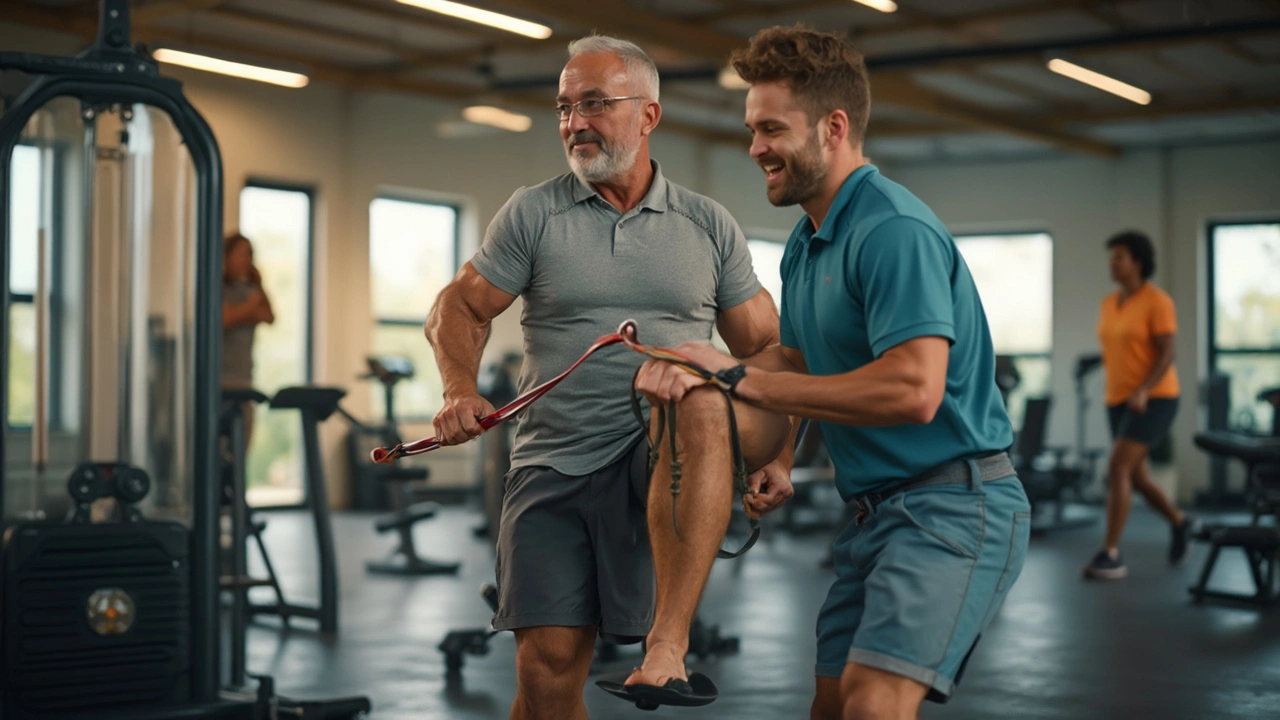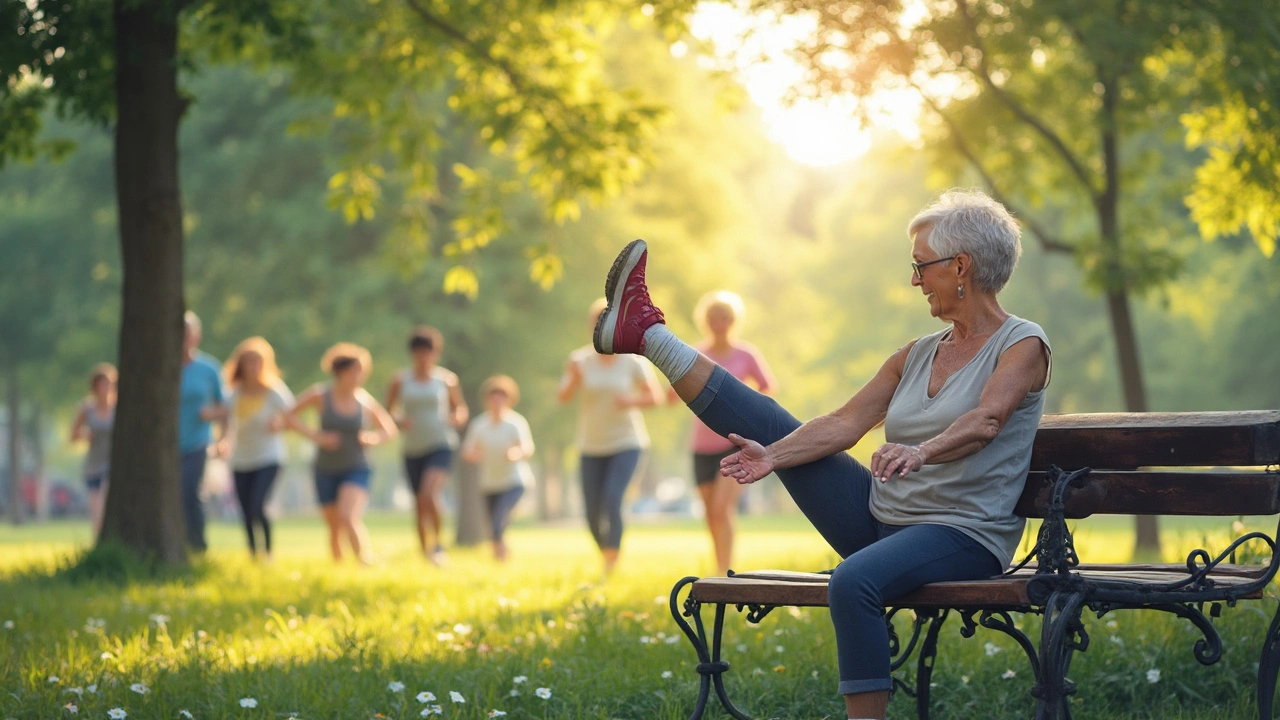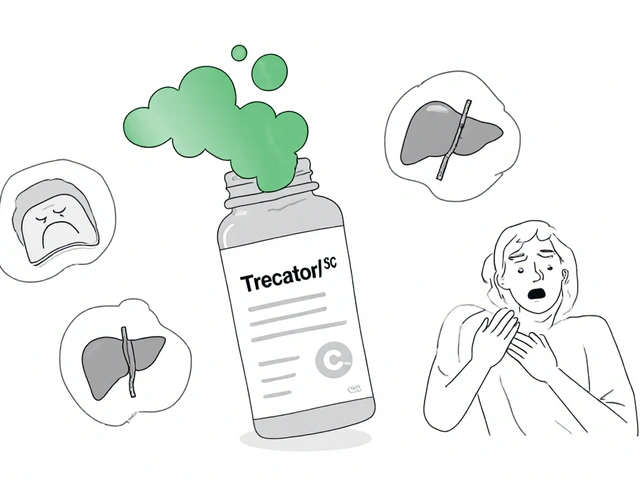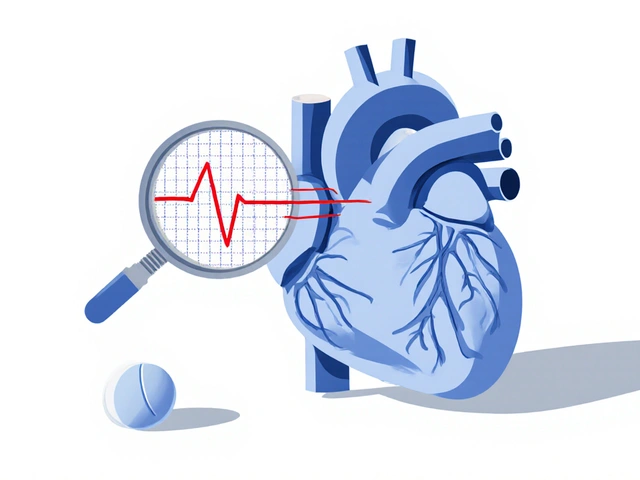Getting active when you've got intermittent claudication can sometimes feel like a daunting task. Trust me, I get it—leg pain is no joke. But, here's a nugget of good news: choosing the right exercises can actually help ease that discomfort.
The first thing to know is that keeping active plays a big role in boosting circulation. Better circulation usually means less pain, which is a win-win, right? Walking for a few minutes and then resting can be a great start. It's like doing intervals, but just aimed at getting blood flowing without pushing the pain too much.
And if you're thinking, 'Walking? That's it?'—well, yeah, at least initially. You can gradually increase your walking time as your comfort level improves, and we'll talk more about other exercise ideas in a bit. Just remember, the key is consistency over intensity.
- Understanding Intermittent Claudication
- The Importance of Staying Active
- Choosing the Right Exercises
- Safety Tips for Exercising
- Tracking Progress
- Staying Motivated
Understanding Intermittent Claudication
Alright, let's tackle what intermittent claudication is all about. In the simplest terms, it's a condition that causes leg pain due to insufficient blood flow to your muscles. Imagine trying to water your garden with a hose that's kinked—everything slows down, right? Well, it's somewhat similar for your blood; the condition is often a result of peripheral artery disease (PAD), where arteries narrow and restrict blood flow.
Now you might be wondering, 'Why do my legs feel like this only sometimes?' That's because the pain usually kicks in during physical activities like walking or climbing stairs, hence the term 'intermittent.' When you push your muscles a bit, they need more blood. And if they can't get it? Yep, cue the pain.
Common Symptoms
Some typical signs are aching or cramping in the calves, thighs, or buttocks after physical activity. The pain usually eases up after a few minutes of rest. But it's not just pain we're talking about; there could also be weakness, heaviness, or tiredness in your legs.
Why It Matters
You might be tempted to just ignore it and sit it out, but addressing intermittent claudication is important. Not only does it affect your quality of life by limiting what you can do physically, but it can also be a sign of more serious cardiovascular issues.
Here's something that might surprise you—a study found that about 20% to 40% of folks with PAD won't even experience claudication pain, meaning it's crucial to keep an eye on other signs or risk factors like smoking, diabetes, and high cholesterol levels.
To wrap this up, understanding what's happening in your body is a big step towards managing the condition. Knowing what's typical and when to seek help can make a world of difference in how you deal with it day-to-day.
The Importance of Staying Active
When dealing with intermittent claudication, it's easy to feel like taking it easy is the best route. But here's the thing—staying active is key to improving your condition. Living with leg pain can be a drag, but regular movement keeps your muscles strong and helps your blood vessels improve circulation.
Why is circulation such a big deal? Simple. Better circulation means more oxygen gets delivered to your legs, reducing the pain you feel when walking or moving around. This is especially important when you have issues with blood flow caused by claudication.
Ever heard the saying 'use it or lose it'? It rings true for muscles. If you don't keep your legs moving, they'll start weakening, making day-to-day stuff a lot harder. Keeping active can preserve your muscle mass and maintain mobility, which is crucial for everyday tasks.
Benefits Beyond Leg Strength
Don't think it's just about leg strength, though. By staying active, you're also helping to reduce the risk of other issues like heart disease, which is a known concern for those with peripheral artery disease. Plus, regular exercise can boost your mood and energy levels. Who doesn't need a bit of that boost?
If all that wasn’t enough, studies have shown that people who exercise regularly experience less pain and higher quality of life. It's not just about the here and now; it's about creating a future where you can enjoy more freedom and less discomfort.
Making a Plan
Staying active doesn’t mean hitting the gym for hours. It can be as simple as a regular walking routine. Here’s how you can start:
- Begin with short walks—just 5 minutes if that's what you can manage.
- Gradually add more minutes each week as you feel comfortable.
- Include some rest-time if pain kicks in—listen to your body.
Remember, every little bit counts. Just staying consistent with these small steps can lead to big improvements in managing your intermittent claudication.
Choosing the Right Exercises
So, you're dealing with intermittent claudication and wondering where to start with exercise? The trick is to find activities that boost circulation but don't leave you hobbling in pain.
Start with Walking
Walking is usually a go-to. It's simple, free, and you can do it almost anywhere. Start with short distances. We're talking about 5 to 10 minutes at a comfortable pace, then rest until your legs feel good again. Gradually increase the walking time as your body lets you know it's okay.
Integrate Strength Training
Working on your legs' strength might sound intimidating, but even light strength exercises can help. Focus on calf raises and leg lifts. You don't need a fancy gym. Bodyweight's your friend here, and you'll be surprised how these movements can improve your circulation and strength over time.
Consider Cycling
Cycling is another awesome option, particularly if you're a bit more adventurous. Stationary bikes are a great choice if you need lower impact activity. It helps with cardiovascular fitness and is easier on the joints compared to pounding the pavement.
Explore Water Exercises
If you're in pain and nothing seems manageable, try swimming or water aerobics. Water naturally supports your body, reducing stress on your legs, while giving you the chance to improve muscle strength and endurance.
Key Precautions
- Listen to your body. If it's shouting, ease back a bit.
- Regularly check with your doctor or physical therapist. They'll have guidance tailored specifically for your needs.
- Warm up and cool down. Keeps injuries at bay, helping your muscles adjust to the activity.
Consistency is key when managing leg pain. With time, your endurance will improve, and so will your comfort level with exercising.
Monitor Your Progress
Lastly, keep tabs on how you feel after different exercises. Jot down what activities feel good and what leaves you cringing. You'll gather valuable insights over time! Your journey to being more active is just that—a journey. Enjoy the little victories along the way.

Safety Tips for Exercising
Getting active with intermittent claudication requires a careful approach. You want to make progress without pushing yourself to a point that can cause more harm than good. These tips can help you find that balance.
Start Slow
It's tempting to jump into a routine thinking it'll pay off quicker, but slow and steady is the way to go. Begin with low-impact exercises. Walking or stationary biking, for a few minutes at a time, can help warm up those muscles.
Listen to Your Body
If your legs start to ache intensely, that's your body's way of saying 'take five.' Rest until the pain eases off and then continue. Pushing through pain isn't worth it here.
Footwear Matters
Wearing the right shoes can make a world of difference. Look for supportive, well-cushioned shoes to absorb shock and provide stability. Proper footwear can help reduce stress on your legs while exercising.
Hydration and Diet
Staying hydrated helps maintain circulation which can fight the tightening effects of leg pain. Also, include a balanced diet with adequate nutrients to support muscle health.
Medication and Exercise Balance
If you're on medication for claudication, timing workouts around your medication schedule might enhance exercise tolerance. Always check with your doctor about how this can work with your specific meds.
| Exercise | Type | Initial Duration | Increase-to Duration |
|---|---|---|---|
| Walking | Low-impact | 10 minutes | 30 minutes |
| Stationary Biking | Low-impact | 5 minutes | 20 minutes |
Remember, the aim is to build up your strength and stamina gradually without overwhelming your body.
Tracking Progress
Keeping tabs on your progress might sound boring, but when dealing with intermittent claudication, it's super helpful. Seeing improvements, even if they're small, can be a big motivator and help you stay committed to being active.
Why Tracking is Key
Let's face it, some days will be harder than others. Tracking helps you visually connect the dots, showing how your efforts are improving your mobility and reducing leg pain. Plus, it becomes your personal cheering team, reminding you how far you've come!
How to Track Effectively
Start by noting the distance you walk or any other activity you're doing. Logging the duration and any discomfort felt during specific exercises can shed light on patterns and help inform when to push forward or take it a bit easy.
- Record daily activity: Keep a small journal or use a fitness app. Write down details like duration, distance, and comfort level.
- Note pain levels: Use a simple scale from 1 to 10 to gauge your leg pain before, during, and after exercising. This way, you can monitor when it's safe to increase intensity.
- Set small milestones: Keep it realistic! Celebrate when you hit personal bests or notice reduced pain, even if just a little bit better than yesterday.
Bringing Data to Life
If you're willing, create a simple chart or table. Visuals can make the journey more engaging, giving a clear picture of improvements over time.
| Week | Activity Type | Distance Covered (miles) | Pain Level (1-10) |
|---|---|---|---|
| 1 | Walking | 2 | 7 |
| 2 | Cycling | 3 | 6 |
| 3 | Walking | 3.5 | 5 |
The idea here isn't to just track for tracking's sake but to ensure you're on a path that really works for you. Whether using high-tech gadgets or pen and paper, the goal is the same: improve comfort and keep moving forward.
Staying Motivated
Let's be honest, staying motivated to exercise when you're dealing with intermittent claudication isn't always easy. The good news? There are plenty of simple tricks to keep you moving without feeling like you're dragging your feet—literally.
Set Achievable Goals
Tackling big fitness goals right out of the gate is a recipe for frustration. Instead, focus on setting small, realistic goals. Maybe this week your goal is to walk an extra 5 minutes a day. Small wins stack up over time, and they're easier on both the mind and the body.
Buddy Up
No one said you have to do this alone. Find a workout buddy who understands your situation—a friend, a family member, or even a support group online. Sharing challenges and achievements can be a huge morale booster.
Track Your Progress
Keeping track of your activity can be a great way to see how far you've come. Whether you use a fitness app or just a simple notepad, jotting down your daily walk time and how you're feeling can offer insight and encouragement.
Mental Tricks
Sometimes it helps to shift the focus from pain to pleasure. Listen to your favorite podcast or playlist while walking. This gives your mind something fun to chew on, distracting from any discomfort.
Celebrate Successes
Don't forget to celebrate the little victories. Finished your walk without hitting the stopping point earlier than planned? That's worth a pat on your back—or maybe even a small treat.
Visual Motivation
Did you know visual cues can help keep you on track? Placing motivational quotes around your home or setting a picture of your travel goal as your phone's wallpaper could serve as a constant nudge in the right direction.
| Motivation Tips | Effectiveness |
|---|---|
| Goal Setting | 80% |
| Walking Buddy | 75% |
| Music/Podcast | 70% |
Staying active even with a condition like leg pain can be a tough cookie to crack, but finding motivation through various strategies can make the journey a whole lot smoother. Remember, it's all about taking one step at a time, literally and figuratively.






17 Comments
They don’t want you to know that simple walking intervals can actually hack the system of blood flow 🚴♂️.
Walking may seem trivial, but when you consider the physiology it becomes a profound act of self‑care. Each step invites a pulse of oxygenated blood, coaxing vessels to adapt. The intermittent nature mirrors the rhythm of life itself, reminding us that progress is non‑linear. Consistency, not intensity, is the quiet teacher that reshapes arteries over weeks. When you pause and reflect, you see that the pain is merely a signal, not a verdict. Your muscles whisper, "I need more flow," and the body obliges if you listen. This dialogue between mind and limb is the essence of healing. It isn’t about sprinting to a finish line; it’s about a sustainable pilgrimage. Gradual increments honor the body's limits while nudging them upward. Think of each walk as a small treaty with your circulation. The treaty is honored when you return, even if only for five minutes. Over time, the terms improve, granting you longer passages before the pain knocks. This patient approach also shields you from injury, a risk when enthusiasm outweighs prudence. Moreover, regular movement fosters a cascade of systemic benefits, from better glucose handling to lower blood pressure. In the grand tapestry of health, these walks are subtle but sturdy threads. So, stride forward with intention, and let the journey be your teacher.
Wow, I totally get the struggle, ,,, walking is like the first step to freedom, but also the step that hurts,,. The article does a great job of breaking things down, ,,,, especially the part about “use it or lose it”,,. I love how it mentions “consistency over intensity”, that’s so true,,. And the water exercises??!!!! Super cool idea,,. Just remember to wear good shoes – that’s a game‑changer, ,,., keep it up!!
Exercise should be done responsibly; pushing through pain without guidance is wrong.
I appreciate the step‑by‑step guide. It’s helpful to see concrete suggestions.
The prose attempts profundity but collapses under a barrage of clichés. One would expect a more rigorous analysis, yet the piece settles for platitudes and vague encouragement. Moreover, the grammar is riddled with inconsistencies that betray a lack of editorial oversight. Such laziness detracts from any genuine insight the author might have offered.
From a clinical perspective, the recommendation to start with short walks aligns with current PAD guidelines. Gradual progression helps avoid over‑exertion while still stimulating collateral vessel growth. Incorporating calf raises can improve muscular endurance without excessive joint stress. It’s also wise to check foot health regularly, as neuropathy can be a hidden issue. Tracking pain levels using a simple 0‑10 scale provides quantifiable data to share with your therapist. Remember to warm‑up with gentle range‑of‑motion movements before each session. Hydration supports circulation, so keep a water bottle handy. Lastly, celebrate each incremental gain; motivation fuels consistency.
Oh great, another “just walk more” post – because that’s never been said before.
Building on what was said earlier, it’s crucial to frame exercise not as a punishment but as a partnership with your body. When you view each walk as a conversation, you naturally attune to the subtle cues your legs send. If the pain spikes, that’s the body’s polite way of asking for a brief pause – honor that request. Over weeks, those pauses become shorter, and the overall tolerance builds. Pairing walking with mindful breathing can also enhance oxygen delivery, creating a synergistic effect. As you log your sessions, look for patterns: maybe a particular time of day yields smoother walks, or a specific route reduces strain. Adjust accordingly to keep the experience positive. Remember, the goal isn’t to race to a distant finish line but to cultivate a sustainable rhythm that serves you day after day. Celebrate the micro‑wins, like adding an extra minute without pain, because those are the building blocks of lasting improvement.
Sure, walking is fine, but why not just sit and wait for miracles?
I’ve seen patients thrive when they combine gentle walking with regular strength drills. The key is to keep the routine enjoyable, so adherence stays high. Listening to soothing music or an audiobook can make the time pass quicker and distract from mild discomfort.
Let’s be clear: you have the power to change your routine, and taking that first step is a bold move. Stay confident, stay active.
I'm curious about the specific duration increments-does a 5‑minute boost every week work for most people, or should it be tailored?
What a fantastic roadmap! 🌟 Your suggestions blend practicality with optimism, making the journey feel both doable and exciting. Keep shining!
Remember to pace yourself and celebrate each small victory; consistency will bring steady improvement over time.
Good tips, keep walking.
Every step you take, no matter how tiny, is a triumph over the ache. Keep moving forward; the path gets brighter with each stride.